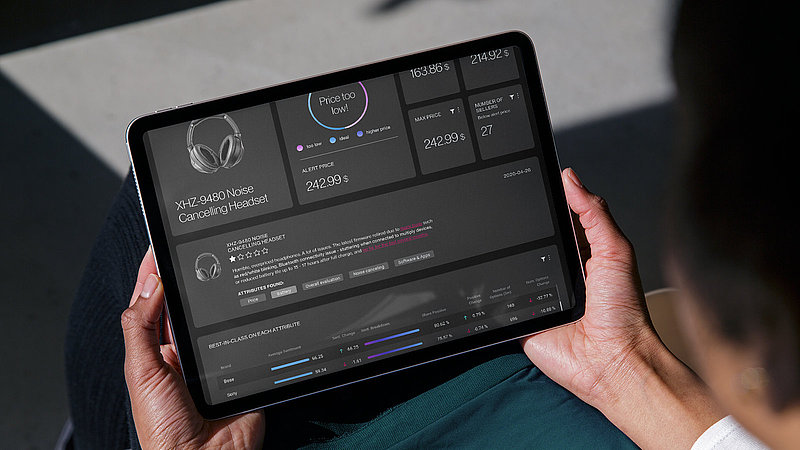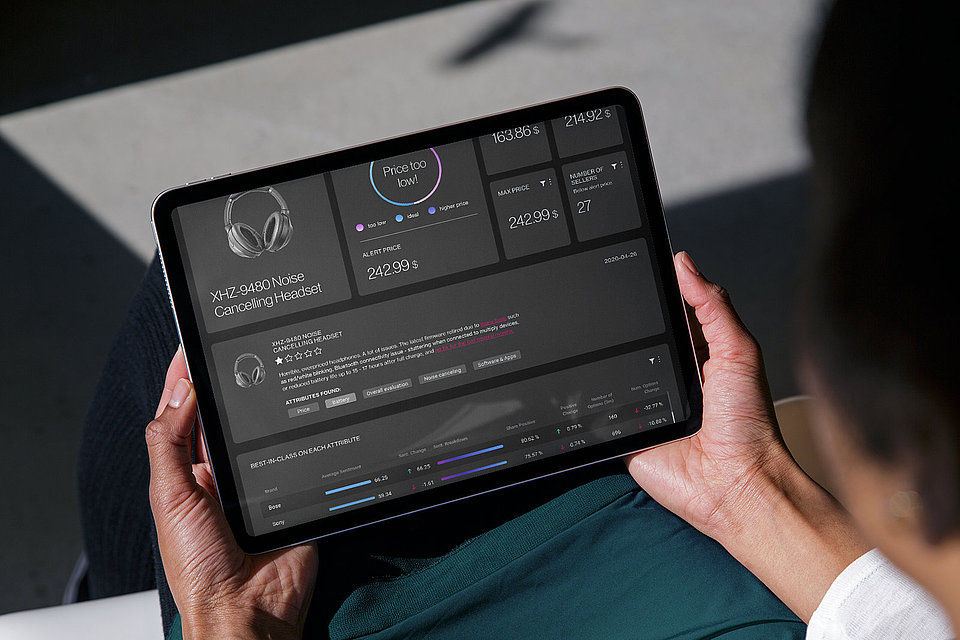What Is Digital Shelf Analytics? Goals, Success Factors, Solutions
What do digital shelf and digital shelf management entail? An introduction to optimising your e-commerce performance.

Which product do you automatically reach for in the supermarket? The pricey, brand-name product at eye-level, or the cheaper option further down the shelves? Did you know that nothing was left to chance in store shelf design? It’s all based on over 100 years of psychological research.
But what about e-commerce? Here, too, companies need to tailor their offers and measures to customer needs – and continuously optimise them to survive. This is where the “digital shelf” comes in, but the term is still relatively new.
So, what do people actually mean by digital shelf, digital shelf management, or digital shelf analytics? We hope this article gives a useful introduction to the topic, with some handy tips for corporate best practice.
What Is the Digital Shelf?
The digital shelf refers to any environment where customers come into contact with a manufacturer’s or retailer’s products online. In other words, all e-commerce customer touchpoints. Strictly speaking, this is the space where the company’s own products are presented and sold, like stores or marketplaces. As such, the term is an analogy to brick-and-mortar shops: the digital point of sale (POS).
In recent years, the digital shelf has evolved to encompass far more than just traditional product detail pages. Nowadays, it incorporates retail media placements, such as Sponsored Products, Sponsored Brands and Display Ads, as well as dynamic rankings, category placements, content variations and premium on-site advertising slots.
Modern digital shelf solutions therefore combine analytics and execution. They provide visibility into prices, content, availability and rankings, and also enable automated optimisation. This means that the digital shelf is actively and intelligently managed, not just monitored.
More broadly, however, the digital shelf also includes a whole range of other touchpoints where products appear or are mentioned, for example, in organic search results or posts on social media.
The digital shelf includes a wide range of channels and locations, such as:
- Own website or shop
- Stores from other retailers (resellers)
- Marketplaces: Amazon, Otto, Zalando, etc.
- Price comparison sites: Idealo, Billiger.de, etc.
- Organic search results on Google, Bing, etc.
- Product search engines: Google Shopping, Ladenzeile, etc.
- Social media: Facebook, Instagram, Pinterest, etc.
- Product recommendations in LLMs

Why Exactly Is Digital Shelf Management So Important in E-Commerce?
E-commerce growth has slowed significantly since 2023. At the same time, advertising costs have continued to rise, while margins have come under pressure due to inflation, logistics costs, and intensified competition.
The growing number of channels, coupled with the increasing complexity of managing them, is overwhelming many teams that are already under considerable strain. The combination of cost pressures, rising customer expectations and greater operational complexity makes automation essential for maintaining control and responding quickly.
How well a product sells depends heavily on how it’s presented – this applies to both bricks-and-mortar retail and e-commerce. However, optimising your own online store is no longer enough, because today’s customers discover products through a wide range of channels. Companies must ensure that their customers enjoy a high-quality shopping experience across all sales channels – and this is where digital shelf management comes in!
The Competition Is Hotting Up
More and more retailers and suppliers are entering the market, and they’re all fighting for the same customers. Plus, product ranges and prices are increasingly converging, making it more difficult than ever to stand out from the competition. Without throwing more money at the problem (advertising, sales promotions, etc.), companies are fighting a losing battle to win over customers in large marketplaces and margins are coming under pressure.
More often than not, growth is only possible by improving the conversion rate. At the same time, retailers are forced to cut costs, for example by reducing return rates or by automating processes.
These Customers Have High Expectations
Online customers are not forgiving! After all, it’s all too easy to buy the same product from a competitor. Product presentation has to be spot on across all channels. Misspellings, poor-quality images or missing product information can ruin conversion and drive up return rates.
Unbelievable Speed
Prices, rankings, ratings… When it comes to e-commerce, everything is fluid. It’s up to manufacturers and retailers to keep a close eye on the market, whether that’s platforms like Amazon, among the competition, on price comparison sites, or in their own stores. Then, quick reactions are essential to avoid falling behind.
The Number of Channels and Touchpoints Is Booming
We’ve already listed the key e-commerce channels above – and yes, there are a lot of them. But that number is only set to rise: the digital shelf is getting bigger and longer, so to speak. Only automation and optimised processes can hand control of the digital shelf back to companies.
Who is responsible for digital shelf management?
Many organisations have introduced new specialist roles to professionalise digital shelf management. These roles collaborate closely with e-commerce, marketing, category management, and pricing teams to optimise visibility, content quality, retail media performance, and overall control of the digital shelf. Depending on the company's size and structure, this may involve individuals or interdisciplinary teams. Either way, it is an increasingly complex undertaking.
The Goals of Digital Shelf Management
The focus of digital shelf management shifts slightly depending on who’s doing the managing: the manufacturer or a retailer.
Retailers are first and foremost focused on monitoring and optimising their own channels, making sure they stay ahead of the competition (other retailers, but increasingly also brands or manufacturers).
Manufacturers, for their part, are more interested in optimally placing and presenting their own product portfolio across all channels (retailers, marketplaces, etc.).
But despite these differences, companies are all chasing the same core goals with digital shelf management:
- Increase conversion and sales
- Reduce number of returns
- Improve competitor standing (prices, rankings, innovations)
- Grow and protect the brand image
- Improve customer experience and satisfaction
- Reduce labour and costs for category management
New objectives have emerged across brands and retailers, including:
- Reducing manual work and improving response times
- Automated alerts and rule-based actions (e.g. for pricing, content and out-of-stock risks)
- Greater efficiency of retail media investments (higher ROAS, reduced waste)
- Margin protection through intelligent price and promotion strategies
- Closing the gap between insights and automated actions
Businesses no longer want to simply observe performance — they want to optimise it continuously and automatically.
So, How to Optimise the Digital Shelf?
The digital shelf encompasses all the online touchpoints at which products are presented, evaluated and sold – including marketplaces, online shops, price comparison portals and retail media. To succeed on the digital shelf, brands must optimise all relevant factors simultaneously: price, availability, content, visibility, reviews and compliance.
Digital shelf optimisation is an ongoing cycle of analysis, optimisation and automation, not a one-off project.
So, how can manufacturers and retailers optimise all aspects of the digital shelf? And what should they be focusing on in each case?
1. Product Range and Availability
- Tailor the product range on offer to target group needs
- Quickly include new products in the range on offer
- Ensure the product range stands out from the competition
- Have products online
- Keep products in stock (because there is nothing that has a more direct impact on sales than products being out of stock)
2. Positioning and Rankings (Organic and Paid)
- Retain high positioning in search results and across retailer/marketplace product listings (Top 10/Page 1, only those who are visible on the first page sell.)
- Win the Amazon Buy Box (and comparable positioning on other marketplaces)
- Book paid ads (Retail Media, Sponsored Listings, Banners, etc.): Use budgets efficiently, high conversion rate
3. Product Content
- Ensure content and grammar/spelling is correct; ensure product texts are up to date and complete (title, description, technical information, etc.)
- Include appealing, up-to-date images and videos that match the brand – of the product, of individual details and features, of the product in use, etc.
- Optimise all content for high conversion and positioning (SEO) and for lowest possible return rate
- Make sure current sales promotions are visible

4. Prices and Sales Promotions
- Always leverage dynamic pricing for competitive prices
- Secure a top spot on price comparison portals
- Make sure selling prices reflect the brand image (manufacturers need to prevent their products from being sold too cheaply)
- Increase sales with impactful sales promotions
5. Customer reviews and feedback
- Ensure positive overall product ratings with at least 4 stars (or comparable) across all channels
- Identify starting points for improvements (by analysing reviews): in content, products, and services
OK, we appreciate that’s a lot of factors! But, if you want to make decisions quickly and with confidence, you need vast amounts of up-to-date data – and at high frequency. And if one thing is clear, it’s that you just can’t pull this off manually.
Central System for Product Information
When it comes to digital shelf management, two technical solutions are needed. The first is a central system for managing all the relevant information relating to your product range. This could be a Product Information Management (PIM) system, Enterprise Resource Planning (ERP) system, or Content Syndication system, containing technical data, metadata, media, marketing content, prices, and so on. Ideally, you should also be able to store user-generated content, such as customer reviews and questions, there too.
All channels are then supplied with data from the system. When it comes to the company’s own channels and external marketplaces with interfaces, the data is usually exported automatically, while retailers who don’t have a connection receive manual exports or read-only access to the system.
The central product information system ensures that all channels are always provided with correct and up-to-date information, reducing the manual labour involved in data maintenance and exchange.
Correct and up-to-date data play an important role in product presentation. But while, at first glance, the central content supply seems to largely solve the problem, in reality, things aren’t quite so simple.
- Automatic data exports rarely work with zero errors. You can’t assume that connected channels will always display the product range fully and correctly.
- Retailers can easily make mistakes when transferring data manually.
- To optimise the digital shelf, companies also need additional information (feedback) from the channels.
With the help of software for digital shelf analytics, you can collect external market data and prepare it for in-depth analysis. However, modern digital shelf systems offer much more than classic PIM with analytics capabilities; they also integrate AI-powered content optimisation, channel-specific content recommendations, automated quality checks and content compliance. This allows brands to ensure that titles, descriptions, attributes and media are implemented consistently, correctly and in accordance with brand guidelines, even on retailer sites where errors are particularly common.
Digital Shelf Analytics (DSA)
Digital shelf analytics involves monitoring your digital shelf with the aim of gaining insights into its performance and deriving action points for optimisation.
But how does this software solution work in real-world terms? Crawlers regularly trawl online stores, marketplaces, comparison and competitor sites to collect any relevant product data – from price to availability and delivery data, from product attributes to texts and images, rankings for relevant keywords, product reviews, and more. The data is stored centrally and prepared for evaluation. The quality and frequency of updates are crucial here: modern platforms crawl thousands of shops worldwide with maximum precision and at high frequency.
Dashboards then give category or e-commerce managers an overview of KPIs, the product’s positioning among the competition, as well as aspects that could impact the brand image. This makes it so much easier for them to analyse information from the individual channels in depth and compare how they’re doing against the competition.

You can set out parameters and arrange to receive automatic notifications in specific cases – say, for example, a product goes offline or out of stock on a channel, the price drops below a certain level or a product gets a series of negative reviews.
Managers can then plan and implement action points to correct errors and systematically optimise product presentation and positioning. You can even arrange for specific actions to trigger automatically, should an event occur, like product content or price adjustments. This evolution turns analytics into a true decision-making and optimisation engine.
A DSA solution makes it possible to monitor ranges totalling millions of products across multiple channels. Spare your e-commerce managers hours of time-consuming manual spot checks. Instead, they can focus on their main job: bringing ever-better products to the digital shelf in a way that speaks to their customer base.

Find out how leading brands are using AI, automation and real-time insights to boost visibility, profitability and efficiency.
We would be happy to discuss your specific use case with you, free of charge and with no obligation.
